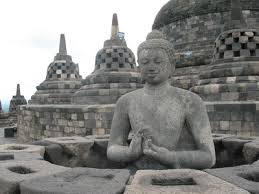Singkarak
Lake is a volcanic lake located in the heart of West Sumatra. With a very
exotic scenery, Lake Singkarak deserve to be one of the place that you have to
visit when traveling to the province of
the Minangkabau.
Lake
Singkarak is a lake That has an area of 107.8 km², being
approximately 21 km long and 7 km wide. The natural outlet for excess
water is the Ombilin river which flows eastward to the Strait of Malacca.
A hydroelectric project however has diverted most of the lake outflow to the
Anai river which flows westward into the Indian Ocean near Padang.
Singkarak
Lake is located at an elevation of above sea level 362,5 m has a typical
fish species which only live in this Lake and the only one in the world. Local
people call it Fish Bilih.
Uniquely
this fish could not be cultivated outside its habitat, both in the aquarium,
pond or floating nets though. Many of these fish were a source of livelihood of
fishing communities around the Lake. You can enjoy the fish that tastes good is
a specific and in the restaurant/bistro on many points of the tourist sites
around the Singkarak Lake .
Singkarak
Lake located in two districts in West
Sumatra, there are Solok and Tanah Datar Districks. With area 107.8 km ² this
lake is the 2nd largest lake in Sumatra Island after Toba Lake .
The location
of lake is very strategic, in the side of the road between Tanah Datar and
Solok City. Because of its location within easy reach, so that tourists can
enjoy the view of the lake at the edge of road twisting. Even tourists who
arrive by private vehicle can enjoy the beauty from their car.
Tour deSingkarak (abbreviated TDS) is an annual professional road
bicycle racing stage race held in West Sumatra,Indonesia, and
named after the Lake Singkarak. First staged in 2009, Tour de Singkarak is
classified by the Union Cycling International (UCI) as a 2.2 category race as
part of the UCI Asia Tour. It covers more than 900 kilometres —
from/to Padang passing around lake Singkarak and runs through inland
West Sumatran cities — and lasted for a week and held annually around May
or June.
Beside for traveling,
Singkarak Lake is also best place for
sport such as Tour de Singkarak (annual professional road bicycle racing),
on land can be for walking, jogging, gymnastics. At the lake for swimming
sports, fishing, rowing and air sports like skydiving.
Lake
Singkarak is located 70 km from Padang, 20 km from Solok and about 36 km from
Bukittinggi.
From
Minangkabau international airport, you can reached Lake Singkarak only about
1.5 hours-2 hours by public transportation or you can take a rented car through
the Padang-Solok route and then take other transportation to the lake. This
journey will take you passed the Sitinjau Laut area which is famous for its
sharp curves and steep canyons.
There are
many hotels near Lake Singkarak such as those along Solok-Bukittinggi main road
and in the Tanah Datar district.








